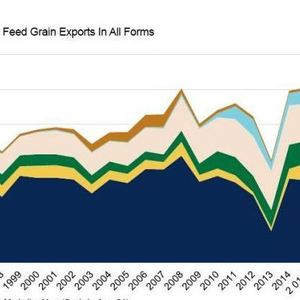US exports of feed grains in all forms reach 2nd highest level

October 26, 2015
BY U.S. Grains Council
The U.S. Grains Council (USGC) estimates 100.1 million metric tons of U.S. feed grains in all forms were exported in the 2014/2015 marketing year, up 800,000 tons from the previous year and the second highest export total on record.
U.S. feed grains in all forms is a measurement including U.S. corn, sorghum, barley, distillers dried grains with solubles (DDGS), corn gluten feed (CGF), corn gluten meal (CGM), ethanol as measured in corn equivalents, meat and poultry as measured in corn equivalents and processed feed grain products.
By accounting for all feed grains that are exported by the United States – in either unprocessed or value-added form – the measure is intended to offer a holistic look at demand from global customers being met by U.S. farmers. It also offers a more expansive view of the amount of U.S. feed grain production being exported.
For instance, in the marketing year that just ended, unprocessed feed grain exports accounted for less than 15 percent of all U.S. production. However, unprocessed grains plus the grain equivalents for value-added products accounted for 26 percent of U.S. production.
That percentage is expected to increase in future years. Using 10-year projections on corn, sorghum, barley, ethanol, meat and poultry, and co-products like DDGS from the U.S. Department of Agriculture (USDA) and ProExporter, the Council estimates that the grain equivalent of these exports will rise to 131 million tons by 2024/2025, accounting for roughly 33 percent of U.S. feed grain production.
Factors influencing this estimate include projected increases in foreign demand for U.S. corn as an animal feed; rising demand for U.S. ethanol to meet other countries’ industrial uses and fuel blending requirements; and rising U.S. meat and poultry exports to developing countries due to the rapid expansion of their middle classes. Increasing demand overseas should also contribute to rising net returns to U.S. feed grain producers.
Gaining access to new and existing export markets is critical to achieve increased sales of both unprocessed and value-added feed grains products. To this end, the U.S. grain industry is highly supportive of broad-based trade agreements such as those in place with Central American countries (CAFTA), Peru and Colombia and, in principle, new agreements like the 12-nation Trans-Pacific Partnership (TPP) and Transatlantic Trade and Investment Partnership (T-TIP) with the European Union.
Once trade agreements are in place, these broad marketplace trends also call for support of market development programs like the Market Access Program (MAP) and the Foreign Market Development (FMD) program, which are part of the U.S. farm bill and support work around the globe by organizations like the Council.
In the weeks ahead, Global Update will examine the performance of each of the major categories in the feed grains in all forms calculations, including the country and regional markets that are driving U.S. sales abroad.
Advertisement
Advertisement
Related Stories
CARB on June 27 announced amendments to the state’s LCFS regulations will take effect beginning on July 1. The amended regulations were approved by the agency in November 2024, but implementation was delayed due to regulatory clarity issues.
Legislation introduced in the California Senate on June 23 aims to cap the price of Low Carbon Fuel Standard credits as part of a larger effort to overhaul the state’s fuel regulations and mitigate rising gas prices.
The government of Brazil on June 25 announced it will increase the mandatory blend of ethanol in gasoline from 27% to 30% and the mandatory blend of biodiesel in diesel from 14% to 15%, effective Aug. 1.
The U.S. EIA reduced its 2025 and 2026 production forecasts for a category of biofuels that includes SAF in its latest Short-Term Energy Outlook, released June 10. The forecast for 2025 renewable diesel production was also revised down.
The U.S. exported 21,545.9 metric tons of biodiesel and biodiesel blends of B30 and greater in April, according to data released by the USDA Foreign Agricultural Service on June 4. U.S. imports of biodiesel were at 4,417.3 metric tons for the month.
Upcoming Events









